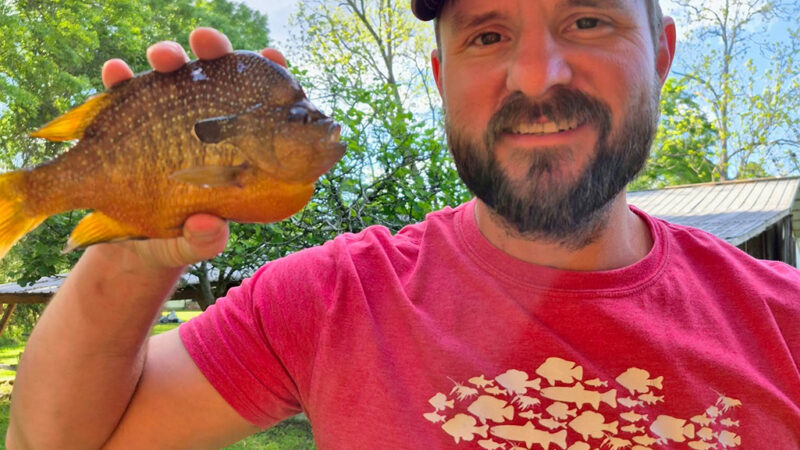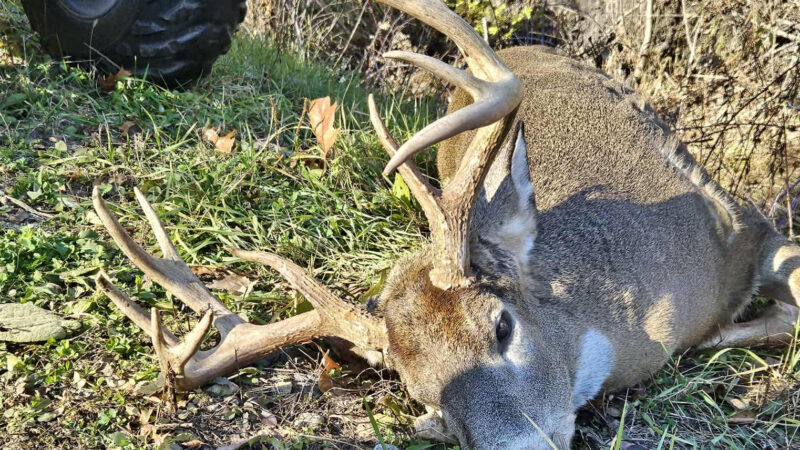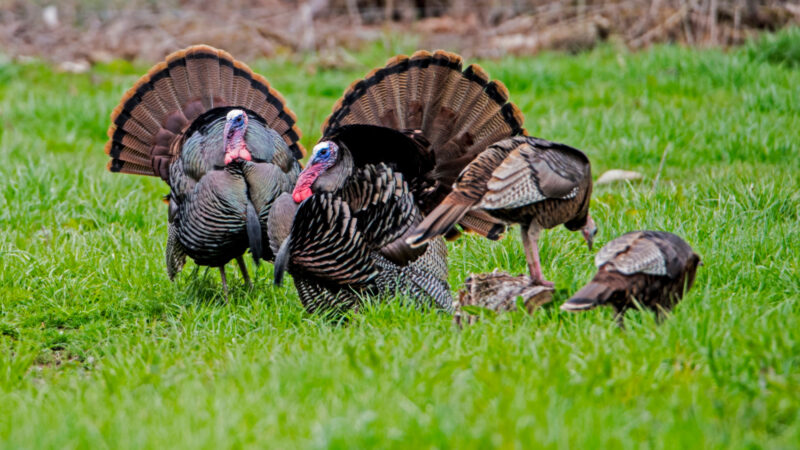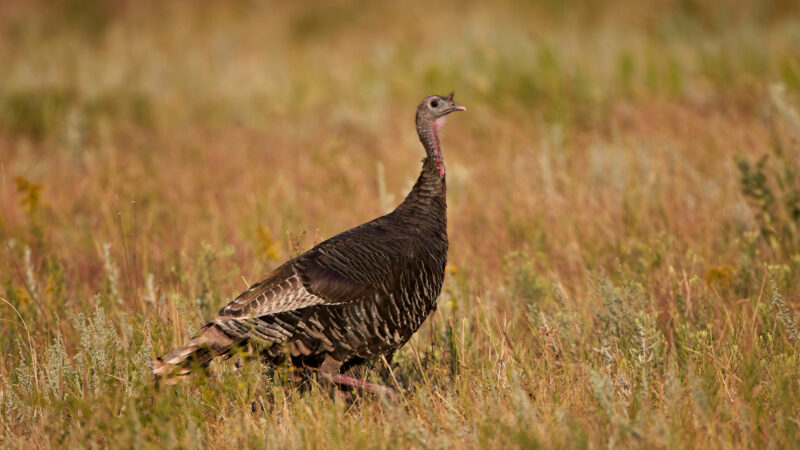Turkey Calling Tips: How to Call a Turkey
Thunder — a term most commonly associated with rainstorms and lightning. But to the turkey hunter, it holds a far different meaning. We learn how to call turkeys so that we can hear the thunder of an excited gobbler break the morning stillness, and so that we can bring that gobbler in close.
I’ve experienced many such mornings, but one stands out in my mind. As I crossed the creek, a tom gobbled loudly on the limb. He was fired up. So was the rest of the flock. I heard every turkey vocalization in the book.
The hunt began a mere 150 yards from the bird. Setting up under an ash tree, all that was left was for the big tom to come struttin’ down the gun barrel. After fly-down, all the turkeys went quiet except for one gobbler I roosted the evening before. He answered every call. I knew he saw the decoys. I also knew he had no hens with him, because I heard them cross over to a neighboring property. If I waited long enough, I’d get a shot at that bird.
Eventually the gobbler finally broke my way. He dropped below a little rise and out of sight. But I knew he was coming. He was committed. His foggy silhouette looked surreal as the sun rose behind him. I served up a soft cluck to stop the tom, and when he halted, I settled the bead of my shotgun and pulled the trigger.
That foggy morning when I witnessed nature at its finest, is one I won’t ever forget. I will always remember the morning when I heard thunder on a day without rain. And I heard just about every other turkey vocalization, too.
If you’re new to turkey hunting, here’s what you should know about how to call turkeys. We’ll cover different turkey vocalizations, types of turkey calls, and turkey calling tips.
Key Turkey Vocalizations to Know
Before you can learn how to call turkeys, you first must understand what sounds they make. Below are the four most important turkey vocalizations to know. Learn to recognize these sounds, understand what they mean, and know how and when to use these calls in the field. For hunters, the most important noises to replicate are the hen yelp, cluck, and cutt. If you can produce these three noises, you can call in turkeys effectively. But, of course, it all starts with identifying the gobble of a wild tom. One of the best turkey calling tips I can offer is to listen to live turkey vocalizations, so dig into the videos and audio files below.
Gobble: The gobble is the staple vocalization for male turkeys. However, hens can make it too (they rarely do). Listen to a tom gobble here. Toms gobble to attract hens, to intimidate other toms, to locate each other, and for a whole host of other reasons that we’ll never fully understand.
Hen Yelp: The plain hen yelp is the staple vocalization for female turkeys. Usually, it’s a series of soft to moderate notes. Yelps can be singular, but they are typically strung together in a series of two, three, four, or more notes. Hens use yelps to communicate with toms during the spring. They also use yelps to locate each other. The yelp is the foundation of turkey calling. One of the best turkey calling tips is to get good at hen yelping. Listen to a hen yelp here.
Cluck: The cluck is a short single note. It is usually used between yelps. It is often used between turkeys in close proximity. This soft social vocalization is common when hens are alternating between feeding and staying in contact with approaching birds. Listen to a hen cluck here.
Cutt: A cutt is basically a cluck on steroids. It is a sharp, short, aggressive note. It’s generally emitted in a fast-paced series of three, four, or more notes. Oftentimes, yelps are emitted at the end of the cutting series. Listen to a hen cutt here.
In the video below, you’ll see a live hen make yelps, clucks, and cutts all mixed together.
More Turkey Vocalizations
Purr: The purr is a quiet series of sounds that turkeys vocalize when they are calm and content. This is often heard from a feeding turkey or one that’s comfortably poking around. Listen to a hen purr here.
Kee-Kee and Kee-Kee Run: The kee-kee and kee-kee run are both considered reunification calls. Usually, this is emitted by turkeys attempting to find the flock or call the flock back together. It can be useful for calling in hens with gobblers. Listen to the kee-kee here.
Putt: The putt is an alarm vocalization that signals danger to other turkeys. This sharp, high-pitched note can be singular, but is usually strung together with other putts with short spacing between them. If you have a gobbler in range and then hear an alarm putt, you better shoot at your first opportunity because they’ll soon be running for cover. Listen to a putt here. Try to avoid making alarm putts when turkey calling.
Tom Yelp: Contrary to popular belief, toms do in fact yelp. Usually, these deep, raspy yelps are made in a series.
Jake Yelp: The sub-adult male bird can yelp, too. It sounds quite like a hen yelp but is slightly different in tone.
Tree Yelp (Tree Call): Best described as soft yelps, the tree yelp (also described as the tree call) is emitted by roosted birds. It’s usually heard early in the morning as daylight nears. Listen to tree yelps here.
Cluck and Purr: This combination is a common social contact call. It also signals contentment and safety. Listen to a cluck and purr here.
Fighting Purrs: An aggressive series of loud, erratic purrs, this is usually emitted by male turkeys as they engage in fighting. This call displays aggression toward other birds. Consider this a last-option call to bring a hung-up gobbler into range.
Spit and Drum: This combo vocalization is made by male turkeys while they’re strutting. It’s only emitted as the turkey reaches peak strut. It’s a quiet sound, and isn’t audible unless you’re close to the bird. If you hear a tom spit and drum, get ready because he’s likely close enough to shoot.
Assembly: The assembly call is a long series of yelps used by hens to bring turkeys back together, and locate lost flock members. It is often heard in the evenings when the boss hen calls others back to the roost. Listen to an assembly call here.
Fly-Down Cackle: The fly-down cackle is usually emitted when a turkey flies up to, or down from, its roost limb. It’s believed to be a signal that lets other turkeys know where they are at the beginning and end of the day. That said, it’s also common when a turkey flies up to or down from a high ridge, regardless of time of day. Some turkey hunters make a flydown cackle first thing in the morning to get the attention of a roosted tom. To imitate the wing beats of a turkey, they’ll flap an empty decoy bag.
Whines: Lastly, the whine is a lesser-known vocalization that hens often use in conjunction with clucks, purrs, and yelps. It’s a social, contact-based call between turkeys. Listen to a turkey whine here.
Remember, when people communicate, they don’t just string random words together. The same is true for wild game. So, when calling turkeys, always consider what each vocalization means. Ensure that your calling makes sense for the situation. Try to have a real conversation with the turkey you’re targeting.
Types of Turkey Calls
There are many different types of turkey calls available to hunters. These include the box, diaphragm, friction (or pot call), and more. Understanding how to operate these and practicing them well before you hit the woods is key to learning how to call turkeys. Read our review of the best turkey calls here.
Box Calls: The box call is a great option for beginners and experienced turkey hunters alike. This friction-based call involves working the paddle (lid) over the sides of the box (trough) to create turkey sounds. Box calls are relatively easy to use and they can run very loudly, which helps with striking far-away toms.
Diaphragm (Mouth) Calls: The diaphragm (mouth) call is another excellent option. While this is not considered a beginner call, it’s important to learn. This hands-free call offers many advantages and boasts utmost realism. Read our review of the best turkey mouth calls here.
Pot Calls: A pot call is basically a flat surface that you rub a striker across. The friction that the striker makes against the surface creates noises (that will ideally sound like a turkey). Pot calls are commonly called “slate calls” even if they do not actually utilize slate. The five common surfaces are slate, glass, crystal, ceramic, and aluminum. Read our review of the best slate calls here.
Push-Button Calls: The friction-based push-button call is oftentimes labeled as the premier beginner turkey call. It’s very simple to operate and takes little to no skill to master. And, it really does call in turkeys. Here’s how a push-button call works.
Scratch Box (Friction) Calls: The scratch box is another friction-based selection. This is an older, lesser-used call. However, it’s closely related to the box and push-button calls, and sounds great.
Shaker Calls: A shaker call is used to make the gobble vocalization. Be careful making gobbles on public land where other hunters might mistake you for a real tom.
Locator Calls: Best described as calls used to make turkeys “shock gobble,” locator calls come in several forms. Some of these include coyote, crow, owl, pileated woodpecker, and more.
Tube Calls: Tube turkey calls are short, tubular calls with a reed or piece of latex. Callers exhale bursts of air to operate the call.
Wing Bone Calls: Perhaps the oldest turkey call, the wing bone is assembled using three bones from a turkey’s wing. These are attached to create a chamber that air passes through while making a “kissing” sound. Here’s how to make your own wing bone call.
Turkey Calling Tips
Turkey calling is a very nuanced skill. Getting good at it takes years of practice. Each scenario requires different calls, volume, cadence, and aggressiveness. While it’s impossible to cover each of these specifics here, it is possible to provide a rough guide on how to call turkeys. These are the turkey calling tips that all beginner turkey hunters should know.
- Each subspecies of turkeys uses the same vocalizations, but their overall sound is slightly different. Study the species you intend to hunt.
- Focus more on the cadence of your turkey sounds than anything else. Even if your pitch and tone aren’t exactly right, you can kill turkeys with the right calling cadence used at the right time.
- Use the weeks and months leading up to turkey season to practice calling. Play an audio track or a video of a live hen and try to mimic her noises.
- Observe how turkeys are responding to your calling, and adjust accordingly. If turkeys are responsive to one type of call, try more of it. If they shut down to a specific call, put it away for the morning.
- Maintain your friction calls with proper care, such as chalking (box calls), sanding (slate calls).
- Over time, your mouth calls, and even others, will wear out. Remember to use new ones once the old calls start sounding poor.
- Record your practice calling, then listen to it back and compare it to the recordings of real hen turkeys.
- If turkeys aren’t responding to locator calls, try some short but aggressive and loud cutting on a turkey call to locate tight-lipped birds.
- Always try to call from a location that turkeys already want to go.
- Know when to use certain turkey calls, such as mouth calls, box calls, and slate calls. For example, on a windy day, a high pitched, loud box call will be more effective at striking toms. When a gobbler is close, you want to use a soft mouth call (so that you can have your hands on your gun, ready to shoot).
- Calling in tandem with a hunting partner can add realism. Imagine that you are both hen turkeys calling to each other.
- If hunting alone, try running a diaphragm (mouth) call and a friction call to make it sound like two hens.
- If a gobbler is gobbling but then hangs up, go silent (stop calling), and he might just come into range. Be patient and avoid the temptation to keep calling at him just to make him gobble again. If a gobbler hangs up he’s likely expecting the hen to come to him. Now you need to out wait him and let curiosity get the better of him.
- Use your hand to “throw” the sound of your mouth calling in different directions. This adds realism by making it seem that hen is turning in different directions.
- Move your friction calls to each side of you, and maybe even twist around, to add the that-turkey-is-moving effect to your friction calling.
- Waterproof box calls make life a lot better in the rainy turkey woods.
- Match your calling to what the hens are doing on that given day.
- Calling less is usually better than calling more.
- Every friction call has a sweet spot or two where the call sounds best. Find these.
- Start calling softly. Then gradually get louder until turkeys hear you.
- Call just loud enough for turkeys to hear and respond, and no louder.
- Match your calling intensity to the situation. If turkeys are super fired up and calling aggressively, you should be too. If turkeys are more subdued, you should be as well.
- Think about a real turkey interaction and try to paint that picture with your calling. Imagine that you are a hen trying to locate a tom. Or maybe you are an aggressive hen trying to pick a fight with another turkey.
- Before you start calling, make sure that you have a good place to set up and hide just in case a gobbler sounds off from close by. If you’re attempting to strike birds, stand with your back against the tree you would sit in front of.
- Match your calling sounds to the decoys you have on display.
- If there are turkeys inside of 100 yards, keep the calling to a minimum, and be very quiet and still. This is where knowing how to purr and cluck with a mouth call comes in handy.
- Once you’ve got a gobbler really fired up and headed in your direction, it’s often most effective to play a bit coy. Go quiet and force that tom to go hunting for you. Listen for his footsteps in the leaves. If he veers in the wrong direction, give him a couple soft clucks.
- Give your soft-calling time to work, because birds don’t always come screaming into the setup. Patience kills turkeys.
- Call to hens. If a gobbler is henned up, then attempt to strike up a conversation with the lead hen (not the tom). If you can entice her, or annoy her, into coming to your set up, the tom will follow.
- Call quietly to roosted turkeys, or don’t call at all. When turkeys are still on the roost, you want to be ultra quiet. A few tree yelps will let them know where you are. Sometimes it’s better to just let the turkeys fly down before calling to them.
Final Thoughts on Turkey Calling Tips
Calling wild turkeys is the most enjoyable part of turkey hunting. Few hunting scenarios match the excitement of talking a fired-up gobbler into range. For beginners, turkey calling can seem pretty complicated, but it doesn’t have to be. Remember the key turkey vocalizations are the yelp, cluck, and cutt. If you can make those three noises and figure out when to use them, you can call in gobblers. Videos are great, but you should also spend as much time as possible in the woods listening to turkeys and talking to them. That’s the only way to truly master calling wild turkeys. The best turkey calling tips will come from the birds themselves.
The post Turkey Calling Tips: How to Call a Turkey appeared first on Outdoor Life.
Source: https://www.outdoorlife.com/hunting/turkey-calling-tips/






